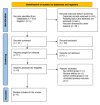Analgesic Efficacy of Remifentanil Versus Dexmedetomidine in Patients Undergoing Bariatric and Metabolic Surgeries: A Systematic Review and Meta-Analysis of Randomized Controlled Trials
- PMID: 40718188
- PMCID: PMC12289400
- DOI: 10.7759/cureus.86691
Analgesic Efficacy of Remifentanil Versus Dexmedetomidine in Patients Undergoing Bariatric and Metabolic Surgeries: A Systematic Review and Meta-Analysis of Randomized Controlled Trials
Abstract
Obese patients undergoing bariatric and metabolic surgeries require tailored perioperative pain management. This review aimed to compare the analgesic efficacy and safety of two adjuncts used in general anesthesia (GA), remifentanil and dexmedetomidine, in this patient population. Using relevant keywords, we searched PubMed, Scopus, the Cochrane Library, and ClinicalTrials.gov, identifying five randomized controlled trials for a qualitative systematic review and quantitative meta-analysis. The RoB 2 tool was used to assess the risk of bias, and the meta-analysis was conducted using RevMan version 5.4. The Grading of Recommendations, Assessment, Development, and Evaluation (GRADE) approach was employed to evaluate the overall quality of evidence. Trial Sequential Analysis (TSA) was used to confirm significant findings. The overall risk of bias was low, and the GRADE quality ranged from moderate to low. Twenty-four-hour opioid consumption and pain scores in the recovery room were comparable between the two groups (mean difference (MD): 0.23; 95% CI: -1.42 to 1.89, P = 0.78; and MD: 0.04; 95% CI: -0.48 to 0.57, P = 0.87, respectively). Postoperative nausea and vomiting (PONV) was significantly lower in the dexmedetomidine group (OR: 2.55; 95% CI: 1.60 to 4.07, P < 0.0001), a finding confirmed by TSA. However, the cumulative sample size represented only 82.5% of the required information size. Overall heterogeneity was low to moderate. Based on the findings of this review, analgesic efficacy, measured by 24-hour opioid consumption and recovery room pain scores, appears comparable between remifentanil and dexmedetomidine. However, the incidence of PONV was significantly lower in the dexmedetomidine group. Further studies are warranted to identify the most suitable adjunct to GA in this high-risk patient population.
Keywords: `anesthesia; bariatric & metabolic surgery; peri-operative analgesia; remifentanil; dexmedetomidine.
Copyright © 2025, Nair et al.
Conflict of interest statement
Conflicts of interest: In compliance with the ICMJE uniform disclosure form, all authors declare the following: Payment/services info: All authors have declared that no financial support was received from any organization for the submitted work. Financial relationships: All authors have declared that they have no financial relationships at present or within the previous three years with any organizations that might have an interest in the submitted work. Other relationships: All authors have declared that there are no other relationships or activities that could appear to have influenced the submitted work.
Figures





Similar articles
-
Drugs for preventing postoperative nausea and vomiting in adults after general anaesthesia: a network meta-analysis.Cochrane Database Syst Rev. 2020 Oct 19;10(10):CD012859. doi: 10.1002/14651858.CD012859.pub2. Cochrane Database Syst Rev. 2020. PMID: 33075160 Free PMC article.
-
Patient-controlled analgesia with remifentanil versus alternative parenteral methods for pain management in labour.Cochrane Database Syst Rev. 2017 Apr 13;4(4):CD011989. doi: 10.1002/14651858.CD011989.pub2. Cochrane Database Syst Rev. 2017. PMID: 28407220 Free PMC article.
-
Perioperative dexmedetomidine for acute pain after abdominal surgery in adults.Cochrane Database Syst Rev. 2016 Feb 18;2(2):CD010358. doi: 10.1002/14651858.CD010358.pub2. Cochrane Database Syst Rev. 2016. PMID: 26889627 Free PMC article.
-
Dexamethasone as an adjuvant to peripheral nerve block.Cochrane Database Syst Rev. 2017 Nov 9;11(11):CD011770. doi: 10.1002/14651858.CD011770.pub2. Cochrane Database Syst Rev. 2017. PMID: 29121400 Free PMC article.
-
Continuous intravenous perioperative lidocaine infusion for postoperative pain and recovery.Cochrane Database Syst Rev. 2015 Jul 16;(7):CD009642. doi: 10.1002/14651858.CD009642.pub2. Cochrane Database Syst Rev. 2015. Update in: Cochrane Database Syst Rev. 2018 Jun 04;6:CD009642. doi: 10.1002/14651858.CD009642.pub3. PMID: 26184397 Updated.
References
Publication types
LinkOut - more resources
Full Text Sources
Research Materials
